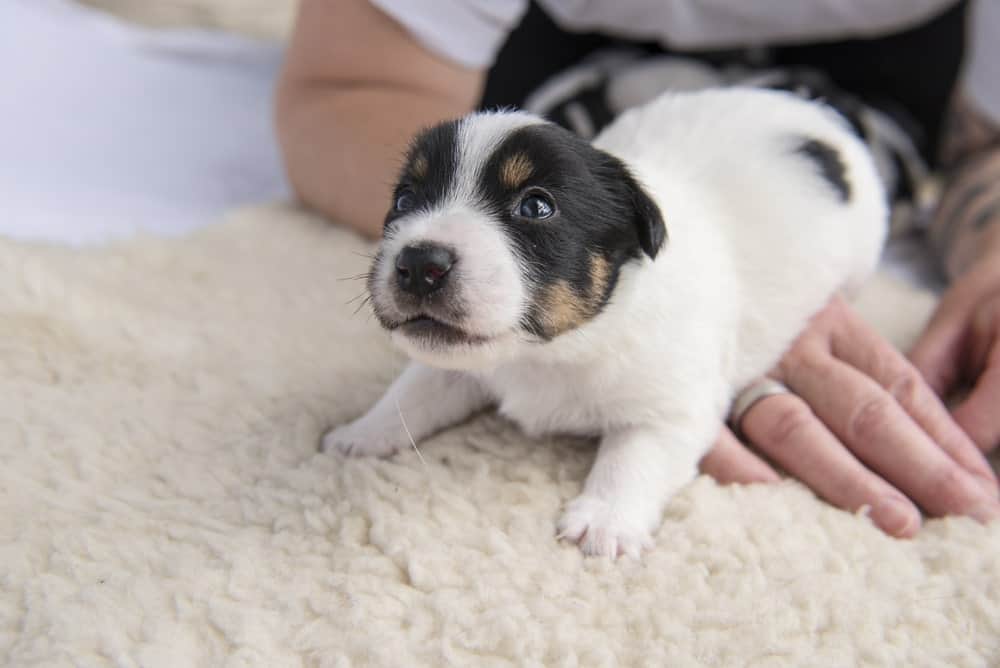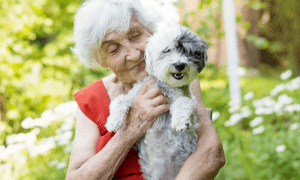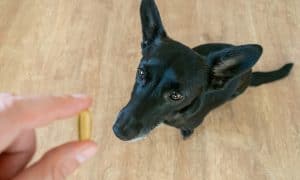“This post contains affiliate links, and I will be compensated if you make a purchase after clicking on my links.”
By Emma Williams
What is swimmer puppy syndrome? What causes it, and how can you tell if a pup has it? What can be done to treat swimmer puppy syndrome, if anything, and what is the prognosis like? The good news is that there’s hope.

What is swimmer puppy syndrome?
Puppies that are physically unable to stand and walk normally are called “swimmers” as they paddle their legs like sea turtles do when stranded on high ground. A swimmer puppy typically lies flat on its chest and belly, with its hind legs extended behind and its forelegs extended to the front and / or sides.
Prolonged inability to stand and walk flattens a swimmer pup’s thorax, causing problems with breathing and preventing the puppy from eating properly. In newborn pups with swimmer puppy syndrome, milk is often regurgitated.
Swimmer puppies often experience difficulty with the entire digestion process; many have difficulty eliminating and develop constipation as a result. Without treatment, a swimmer puppy is also at risk of developing painful joint deformities caused by holding their legs at abnormal angles for long periods of time.

Symptoms of swimmer puppy syndrome
Besides paddling their legs like little turtles or pulling themselves along on their bellies like snakes, how can you tell if a puppy is a “swimmer?” There are a few things to look for:
- The puppy’s chest will appear flattened rather than rounded.
- You’ll probably notice that the puppy has some difficulty breathing.
- Swimmer puppies are often lethargic.
- By one week of age, the pup’s legs will usually appear to be permanently splayed to the sides, no matter how the puppy is held.
- By three weeks of age, the puppy will not be developing the ability to stand and walk like its littermates.
If you notice any of these syndromes or have even the slightest suspicion that a puppy is a “swimmer,” then call your veterinarian ASAP. The sooner treatment can begin, the better the puppy’s outlook is likely to be.
What causes swimmer puppy syndrome?
Small and dwarf dog breeds are more prone to swimmer puppy syndrome that large breeds. Since this condition isn’t common, little research has been conducted to determine the cause. Some veterinary experts believe that the issue is hereditary, while others point toward environments that prevent puppies from moving enough to develop their muscles properly. Others believe that swimmer puppies are born with congenital defects that occur prior to birth.
Whatever the cause of swimmer puppy syndrome, the good news is that this condition is often treatable.

How is swimmer puppy syndrome treated?
Once upon a time, the only “remedy” for swimmer puppy syndrome was humane euthanasia. Today, these puppies aren’t hopeless cases.
Many veterinarians are willing to intervene and give the puppy a chance at having a happy, healthy life as there are quite a few treatments for swimmer puppy syndrome. Your vet will be able to determine whether these or other options are viable, as every individual is unique.
- Use a harness or sling to suspend the puppy for up to 20 minutes at a time, up to four times per day. This treatment is intended to strengthen muscles while taking pressure off the chest and abdomen.
- Have your veterinarian show you how to hobble or tape the puppy’s legs into the correct position. Every case is different; however, this is normally done gradually, for just 15 to 20 minutes per day, and only 3 to 4 times per day at first. It’s usually paired with the harness or sling method, with the puppy’s paws lightly touching the ground but not supporting the pup’s weight at all.
- Avoid slippery surfaces that prevent the pup from gaining traction.
- Make sure that bedding is fluffy and soft, so the pup’s thorax isn’t as tightly compressed as it would be on a hard surface. You can also create a soft vest for the pup to wear by cutting leg holes in an old sock and stuffing the sock with fluffy material to keep the chest elevated.
- Encourage the puppy to sleep on its side rather than resting on its abdomen. When you are with the puppy, help it change positions while nursing and sleeping.
- Use a soft toothbrush to tickle the puppy’s paw pads at least a few times per day. This gentle stimulation can help with nerve development and encourage the puppy to move its legs more, as well as to exert more force with each movement.
- Massage the puppy frequently, particularly after feeding. All-over massage can help stimulate muscles and nerves while aiding the digestion process.
- Stand the puppy up and use your fingers to gently encourage “walking” motions with the legs. You can also encourage these movements while the puppy is suspended in a sling.
- Ensure that the puppy is being fed adequately, but not over-fed. Excess weight makes recovery more difficult.
- Keep the puppy clean. Because swimmer puppies aren’t able to relive themselves properly, they’re prone to lying in their own waste. This can lead to painful lesions and cause complications with treatment. Apply a moisture barrier cream or unscented baby powder to help prevent irritation, if your vet approves.
Conclusion
It takes time and dedication to treat a pup with swimmer puppy syndrome, but a positive outcome is often possible.
Emma Williams is a professional writer and blogger, with two furry friends and a lot of pet behavioral and pet health knowledge to share. She has written for numerous big animal magazines and health sites, and is a regular contributor to The Dogington Post.



















Pingback: Moments before pup is put down, shelter director makes a decision that saved her life
Pingback: How a Physical Therapist Helped This Tiny Paralyzed Puppy - Indeki - Real News Network